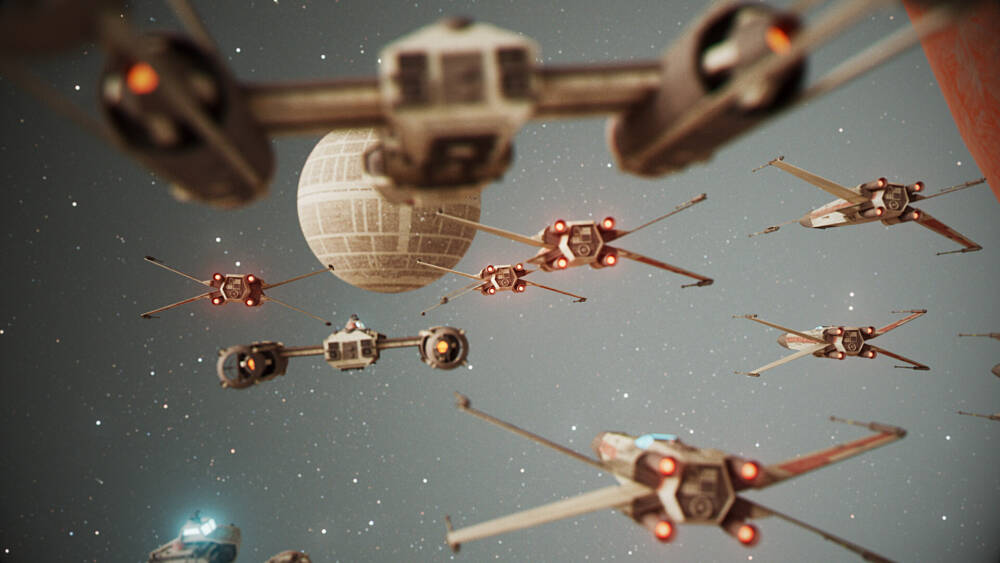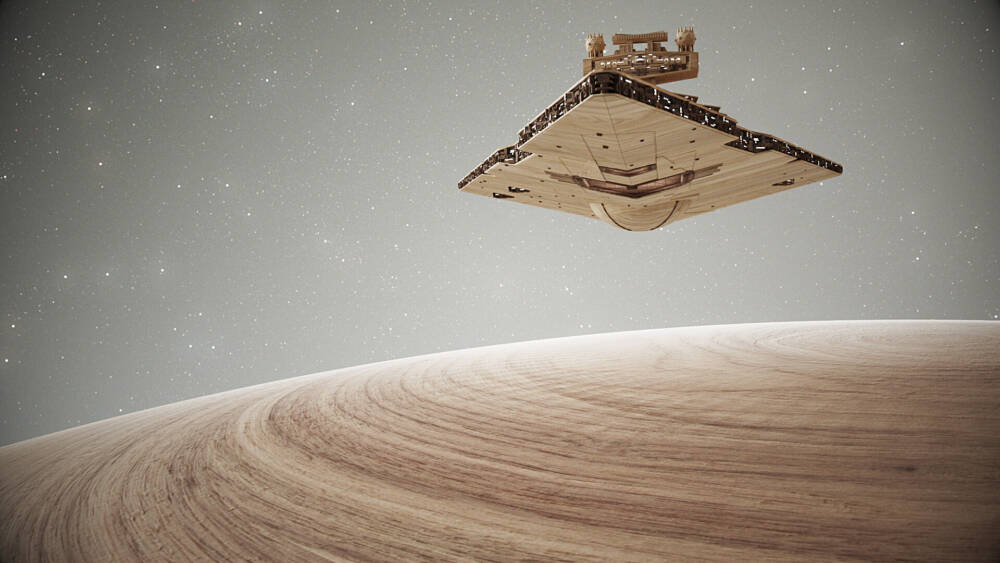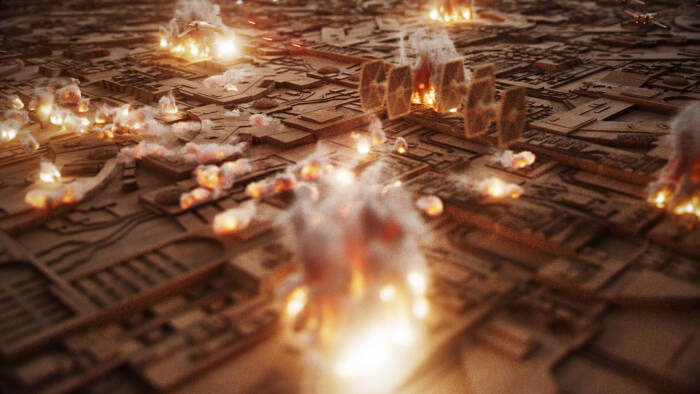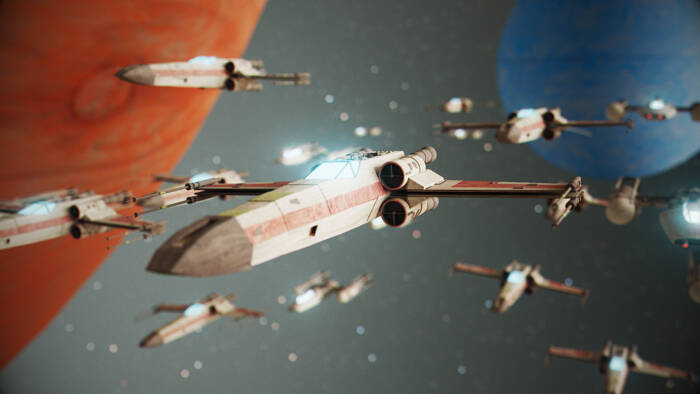Making ‘Star Wars: The Wood Cut’
Aharon Rabinowitz explains how he reimagined the movie that inspired his career.
Aharon Rabinowitz was three years old when the original “Star Wars” film was released, and he saw it in the theater. He didn’t understand much about it, other than that there were good guys and bad guys, “but the visuals blew me away,” he recalls, particularly the hologram of Princess Leia pleading “Help me, Obi-Wan-Kenobi. You’re my only hope.”
A few months later, after seeing “The Making of Star Wars” documentary on TV, he decided he would be a VFX artist. Not surprisingly, the first thing Rabinowitz ever animated was a lightsaber, and his first 3D project was an X-Wing fighter. Over time, he’s made visual effects the center of his career as a filmmaker, software designer and visual artist working in VFX and motion design.
We talked to Rabinowitz, who previously served as Global Head of Digital Experience at Maxon and the Head of Marketing for Red Giant, about his newly released short film, “Star Wars: The Wood Cut.” Created using Cinema 4D, Redshift and Red Giant Magic Bullet Suite and Universe, the animated short reimagines the “Star Wars” galaxy on a much smaller scale and made of entirely of wood.

Aharon, tell us about how you got into the industry.
Rabinowitz:I started out with an internship at “Sesame Street,” and ended up getting a job as a technical manager with them. I was using After Effects and the 3D software that they had, and I liked it so much, I realized that’s what I wanted to do.
Soon after, I was hired as an animator and motion designer by Viacom Networks to work on projects for Noggin, a child company of Sesame Workshop and Nickelodeon. That lead to work on their other networks, like MTV, VH1, Nickelodeon and TV Land. After some time there, I started my own video production company, where I was getting spillover work from Viacom and many other new clients.
But when my daughter was born, I realized I wanted time to be there for my kids and couldn’t work 100 hours a week anymore. I had been making tutorials and training for Creative Cow in my free time for a while, so my next move was to Red Giant doing training and marketing, and for the last 15 years or so I’ve mostly being doing animation and video training, as well as development and marketing of mograph/VFX software.
Talk about your film and why you wanted to use wood cuts?
Rabinowitz:In some ways, “Star Wars: The Wood Cut” is a way for me to stay current and relevant to the kind of work people are doing that I want to do too. It started off as me trying to work with Redshift and the new C4D Pyro simulations. And I wanted to see what the “Star Wars” universe might look like if it were made entirely out of unexpected materials.

I wanted to make something that felt completely “Star Wars,” but also entirely unique. A friend of mine is a woodworker, and I tried to imagine what it would look like to make a stop-motion film using wood cuts.
You did a tutorial series on the project. Tell us about that.
Rabinowitz:I learned a lot in the process of making this film. It’s probably the most I’ve learned in such a short period of time since my early days of animation. Like my old days, when I made After Effects tutorials as I learned on the job, I felt like there were a lot of artists out there who could benefit from what I just learned.
So I put together a series of tutorials that cover the Pyro effects, camera techniques and a few other VFX. I had so much fun making this, and I love sharing my process so that other people can feel the same joy in their own work.
Describe your process, including how you used different software?
Rabinowitz:I barely knew how to use Redshift when I started this project. But once I drilled down, it wasn’t hard to learn, and I can honestly say anybody can learn it if they want to.
One of the cooler parts of this was working with Pyro. I wanted the piece to look real and sometimes VFX can take away from that. Pryo was a good mix of somewhere between real and crafty, and I learned how to get explosions to look great by using C4D’s Voronoi Fracturing to give objects trails when they blew up.
Another big part of this project was working with bokeh. If you want something to feel real, you need shallow depth of field. And the lasers and lights on the ships also helped things stand out more. I used a vibrate tag for some of the motion and had nulls with the cameras, so they could be in motion without being complicated to use. I really tried to find ways to simplify everything and break it down into smaller problems to bring things together as a whole.
How much modeling did you do for this film?
Rabinowitz:This was a six-week personal project that I worked on nights and weekends during Christmas vacation. If I had modeled everything from scratch, it would have taken a LOT longer as I’m much better at animation than modeling. I got the 3D Models from Sketchfab, and then removed some of the geometry and details and re-textured them.
I wanted the models to look like they really were small and carved out of wood, which means that they had to look much simpler and rough around the edges. There was no end to the number of “Star Wars” models on Sketchfab, and they have Creative Commons licenses, so you need to credit the artists, which I did. Cinema 4D can open many of their formats, so they were easy to work with. It was hard work with the models, but once I got to animating in C4D, I was in my element. I love animation.
Still, as any artist has experienced, there was a point where I wasn’t sure whether what I was doing was any good anymore. When you look at the same project every night, it’s easy to doubt yourself. So I showed it to Stu Maschwitz [Maxon’s chief creative officer and ILM veteran], and he loved it and gave me some extremely helpful suggestions that galvanized me again.
He even started sending me some bespoke wooden sound effects. At his advice, I ended up mixing big “Star Wars” SFX with the sounds of wooden toys, and that really worked well.
What kind of feedback have you gotten so far?
Rabinowitz:It’s been great. ILM and Mark Hamill responded on Twitter with praise, and that meant a lot to me to hear from the people who so profoundly impacted my career. And my friends at Territory Studios and other post-production companies have reached out to say how much they loved it. So the response has been great and a good reminder to me that despite working in software tools and marketing, I’m still an artist and have more to say.
You know, you see people’s amazing work and you think: ‘I can’t do that.’ I would have thought that if I’d seen this project, and I really want to say that I don’t think I am that talented as an artist. I have a lot of technical knowledge, and wouldn’t even say I used the best practices, but I learned a lot and in the end it was enjoyable.

I wanted people to see there is so much more to bring to 3D than just knowing how to use 3D. Look at the people you admire and replicate it because that’s how artists learn. You don’t have to know everything, just start with your passion and always talk to people and get honest feedback.
Writer/Editor: Meleah Maynard
Photo credits: © Aharon Rabinowitz, 2023



